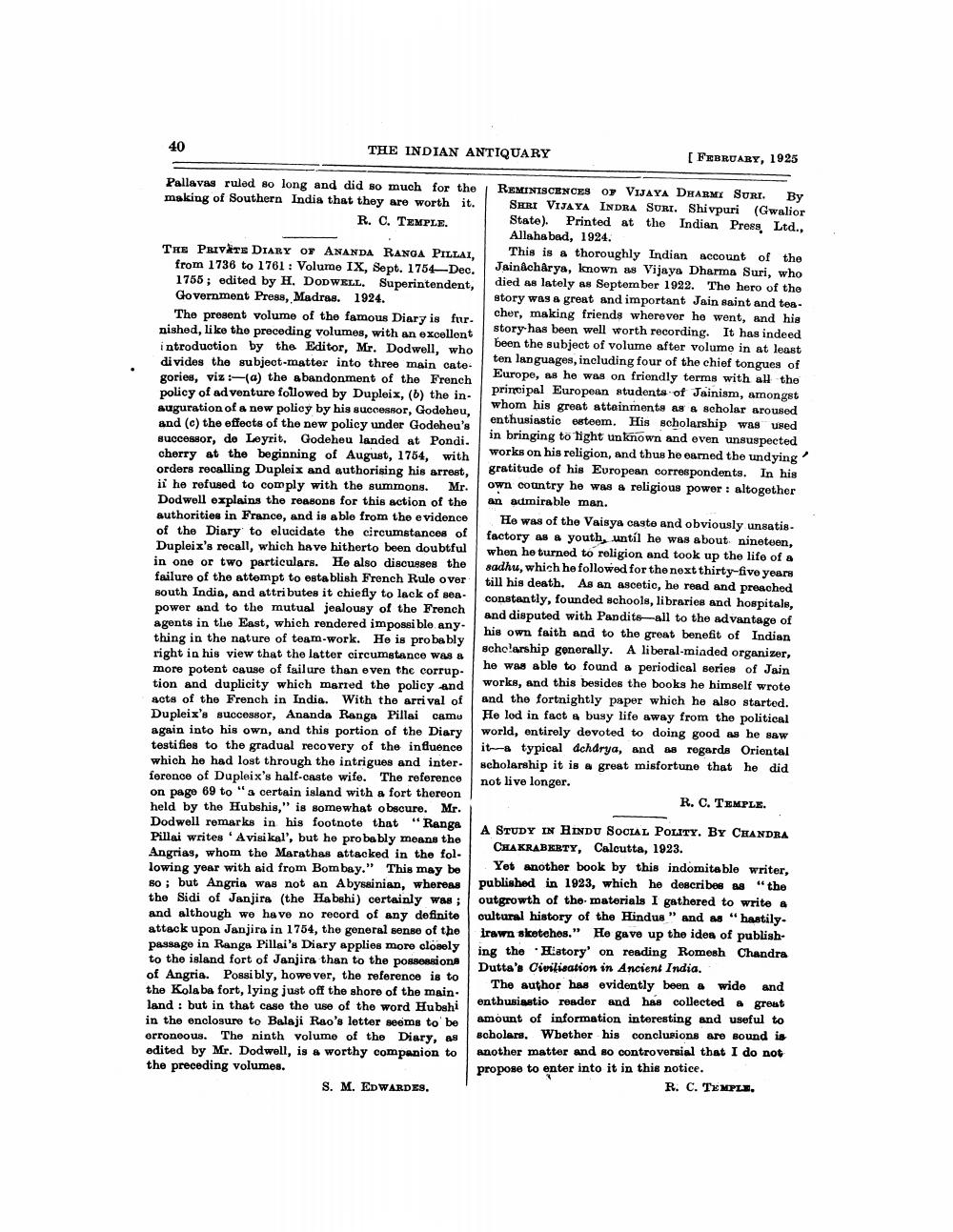________________
40
THE INDIAN ANTIQUARY
[ FEBRUARY, 1925
Pallavas ruled so long and did so much for the REMINISCENCES OY VIJAYA DHARMI SURE. By making of Southern India that they are worth it. SERI VIJAYA INDRA SURr. Shivpuri (Gwalior
R. C. TEMPLE.
State). Printed at the Indian Press, Ltd.,
Allahabad, 1924. THE PRIVATE DIARY OY ANANDA RANGA PILLAI,
This is a thoroughly Indian account of the from 1736 to 1761: Volume IX, Sept. 1754-Dec.
Jain charya, known as Vijaya Dharma Suri, who 1755; edited by H. DOD WELL. Superintendent,
died as lately as September 1922. The hero of the Government Press, Madras. 1924.
story was a great and important Jain saint and tes. The prosent volume of the famous Diary is fur.
cher, making friends wherever he went, and his nished, like the preceding volumes, with an excellent
story has been well worth recording. It has indeed introduction by the Editor, Mr. Dodwell, who
been the subject of volume after volume in at least divides the subject matter into three main cate
ten languages, including four of the chief tongues of gories, viz :-(a) the abandonment of the French
Europe, as he was on friendly terms with all the policy of adventure followed by Dupleix, (b) the in
principal European students of Jainism, amongst auguration of a new policy by his successor, Godeheu,
whom his great attainments as a scholar aroused and (c) the effects of the new policy under Godeheu's
enthusiastic esteem. His scholarship was used successor, de Leyrit. Godeheu landed at Pondi.
in bringing to fight unknown and oven unsuspected cherry at the beginning of August, 1764, with
works on his religion, and thus he earned the undying orders rocalling Dupleix and authorising his arrest, gratitude of his European correspondents. In his if he refused to comply with the summons. Mr. own country he was a religious power : altogether Dodwell explains the reasons for this action of the an admirable man. authorities in France, and is able from the evidence He was of the Vaisya caste and obviously unsatisof the Diary to elucidate the circumstances of factory as a youth, until he was about nineteen,
factory as youth. until he was shont. Dupleix's recall, which have hitherto been doubtful when he turned to religion and took up the life of a in one or two particulars. He also discusses the sadhu, which he followed for the next thirty-five years failure of the attempt to establish French Rule over till his death. As an ascetic, he read and preached south India, and attributes it chiefly to lack of sea.
constantly, founded schools, libraries and hospitals, power and to the mutual jealousy of the French
and disputed with Pandits-all to the advantage of agents in the East, which rendered impossible any.
his own faith and to the great benefit of Indian thing in the nature of team-work. He is probably
scholarship generally. A liberal-minded organizer, right in his view that the latter circumstance was a
he was able to found a periodical series of Jain more potent cause of failure than even the corruption and duplicity which marted the policy and
works, and this besides the books he himself wrote acts of the French in India. With the arrival of
and the fortnightly paper which he also started. Dupleix's successor, Ananda Ranga Pillai camu He lod in fact a busy life away from the political again into his own, and this portion of the Diary world, entirely devoted to doing good as he saw testifies to the gradual recovery of the influence it--- typical dchdrya, and as regards Oriental which he had lost through the intrigues and inter. scholarship it is a great misfortune that he did forence of Dupleix's half-caste wife. The reference
not live longer. on page 69 to "a certain island with a fort thereon
R. C. TEMPLE. held by the Hubshis," is somewhat obscure. Mr. Dodwell remarks in his footnote that "Ranga
Ranga | A STUDY IN HINDU SOCIAL POLITY. BY CHANDRA
A ny Pillai writes 'A visi kal', but he probably means the
CHAKRABERTY, Calcutta, 1923. Angrias, whom the Marathas attacked in the fol. lowing year with aid from Bombay." This may be
Yet another book by this indomitable writer, 80 ; but Angria was not an Abyssinian, whereas published in 1923, which he describes as "the the Sidi of Janjira (the Habshi) certainly was ; outgrowth of the materials I gathered to write a and although we have no record of any definite cultural history of the Hindus" and as "hastily. attack upon Janjira in 1754, the general sense of the irawn skotehos." He gave up the idea of publishpassage in Ranga Pillai's Diary applies more closely
ing the History' on reading Romesh Chandra to the island fort of Janjira than to the possessione
Dutta's Civilisation in Ancient India." of Angria. Possibly, however, the reference is to
The author has evidently been a wide and the Kolaba fort, lying just off the shore of the main. land: but in that case the use of the word Hubshi
enthusiastio reader and has collected a great in the enclosure to Balaji Rao's letter seems to be
amount of information interesting and useful to orroneous. The ninth volume of the Diary, as
scholars. Wbether his conclusions are bound is edited by Mr. Dodwell, is a worthy companion to another matter and so controversial that I do not the preceding volumes.
propose to enter into it in this notice. S. M. EDWARDES,
R. C. TEMPLE.




